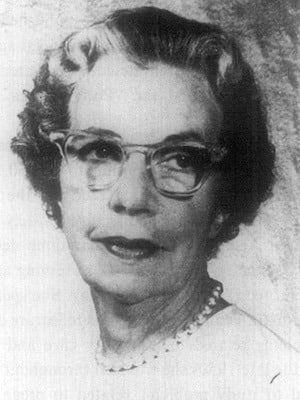Edith Potter
Edith Louise Potter (1901 – 1993) was an American pediatric pathologist.
Potter devoted her career to becoming one of the founders of perinatal pathology following her realisation of high infant mortality rates. Through her pioneering work she challenged perceptions of neonatal deaths and reduced infant mortality rates.
She was the first female member of the American Gynaecological society and worked all over the world, receiving honorary degrees from multiple universities. The Potter name is eponymously remembered with Potter facies (1946); Potter syndrome; Potter sequence and the Potter classification of polycystic kidney disease (1952 and 1964).
Biography
- 1901 – Born 26 September, Clinton, Iowa, United States
- 1919 – University of Minneapolis. (BS in 1923 and MB in1925)
- 1925 – Moved to Vienna
- 1927 – Started a medical practice in Minnesota, working for 5 years in private practice
- 1934 – Obtained a doctor of philosophy degree in pathology
- 1939 – Published a paper alongside Dr Adair showing the two leading causes of infant death were hypoxia and haemorrhage secondary to traumatic labours
- 1943 – Married Alvin Meyer (architectural sculptor)
- 1952 – First edition of “Pathology of the Fetus and Newborn infant” published – final edition published in 19675 with John Craig
- 1967 – Retired from the University of Chicago and the Chicago Lying in Hospital where she worked for over 30 years first as an instructor and later a professor. She published over 140 papers and 6 books in this time.
- 1967 – First husband passed away and married Frank Deats, a childhood friend
- 1983 – Inducted into the Hall of Fame of the American College of Obstetricians and Gynaecologists in Washington, DC
- 1993 – Died 22 March at sea whilst taking a cruise in the Caribbean, age 91 years
Medical Eponyms
Potter facies (1946)
The facial characteristics of infants with bilateral renal agenesis. In 1946, Potter reported the autopsy findings of 20 infants (a group of 17 male and 3 female babies in a series of 5000 foetal and neonatal autopsies) who suffered bilateral renal agenesis and died in the perinatal period.
Two anomalies were observed in almost all of these infants which to my knowledge have not previously been recognised as characteristically associated with renal agenesis. These are hypoplasia of the lungs and an abnormal facial expression.
The peculiar facies of these infants likewise seems to have no specific embryologic correlation with the renal anomaly. The face most characteristically exhibits an increased space between the eyes, a prominent fold which arises at the inner canthus and sweeps downward and laterally below the eyes, an unusual flattening of the nose, excessive retraction of the chin, and a moderate enlargement and decreased chondrification of the ears (Potter’s ears). The face gives a suggestion of premature senility and is sufficiently characteristic to warrant a diagnosis of co-existing renal aplasia when it is observed.
Potter 1946
- Potter syndrome: total absence or malformation of infant kidneys in combination with other congenital abnormalities, including Potter facies, pulmonary hypoplasia, oligohydramnios, failure of fetal urinary production and musculoskeletal anomalies such as clubbing of the hands and feet.
- Potter ears: characteristic low set flat ears deficient in cartilage associated with Potter facies.
- Potter sequence: constellation of findings observed postnatally as a consequence of severe, prolonged in utero oligohydramnios (not just severe renal disease).
Potter classification of polycystic kidney disease (1964)
Potter initially defined a group of four renal cystic diseases in Pathology of the fetus and the newborn (1952: 368-376). A more refined systematic classification was made in conjunction with Osathannondh in 1964.
- Potter type I: infantile polycystic kidney disease
- Potter type II: multicystic dysplastic kidneys
- Potter type III: adult polycystic kidney disease
- Potter type IV: obstructive cystic renal dysplasia (renal cysts in infants with posterior urethral valves)
Major Publications
- Potter EL, Adair FL. Fetal and neonatal death. University of Chicago Press, 1939.
- Potter EL. Facial characteristics of infants with bilateral renal agenesis. Am J Obstet Gynecol. 1946; 51: 885-888 [Potter’s facies]
- Potter EL. Bilateral renal agenesis. J Pediatr. 1946; 29: 68-76
- Potter EL. Rh, its relation to congenital hemolytic disease & to intragroup transfusion reactions. 1947
- Potter EL. Fundamentals of human reproduction. 1948
- Potter EL. Pathology of the fetus and the newborn. 1952
- Potter EL. Pathology of the fetus and infant. 1961
- Osathannondh V, Potter EL. Pathogenesis of polycystic kidneys. Archives of Pathology, 1964; 77: 459-509
- Potter EL. Normal and abnormal development of the kidney. 1972
References
- Hoffman NY. Edith Potter, MD, PhD: pioneering infant pathology. JAMA. 1982; 248(13): 1551-1553.
- Beighton P, Beighton G. POTTER, Edith. In: The Man Behind the Syndrome. Springer 1991: 223
- Gilbert-Barness E. Profiles in paediatrics II – Edith Potter. J Pediatr. 1995; 126(5 Pt 1): 845-846.
- Dunn PM. Dr Edith Potter (1901-1993) of Chicago: pioneer in perinatal pathology. Arch Dis Child Fetal Neonatal Ed. 2007; 92(5): F419-F420
- Bibliography. Potter, Edith Louise 1901-1993. WorldCat Identities
- Baskett TF. Eponyms and Names in Obstetrics and Gynaecology. 3e. 2019: 331-332
Graduated from Cardiff Medical School in 2017 with MBBCh and BSc in Psychology and Medicine. Currently working as a doctor in the emergency department at Sir Charles Gairdner Hospital in Perth, Australia.



